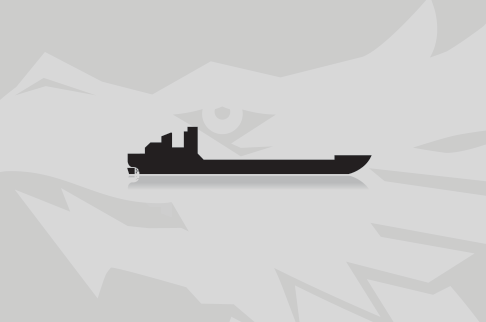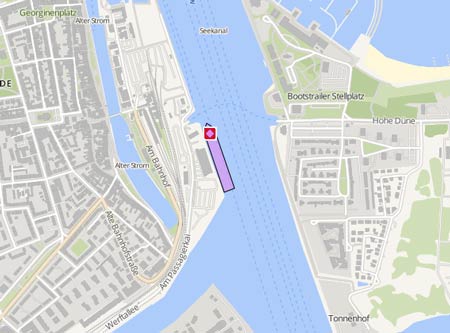INVESTIGATOR
Course/Position
Latest ports
Latest Waypoints
Latest news
Wreck surveyed by Investigator identified as SS Nemesis
The 'Investigator' has located the steamship SS 'Nemesis', which sank in July 1904 while transporting coal to Melbourne in a powerful storm. All 32 people on board were considered lost, and in the weeks that followed, the bodies of crew members and debris from the ship washed ashore. The wreck was initially spotted when searching for sunken shipping containers. In 2022, a remote sensing company called Subsea Professional Marine was trying to find cargo boxes lost off the coast of Sydney when it came across the shipwreck by chance. The vessel, which could not be officially identified at the time, was about 16 miles offshore and 525 feet deep. Government officials suspected the wreck might be the SS 'Nemesis', but it wasn't officially confirmed until September 2023 when CSIRO, Australia's national science agency, was able to capture underwater imagery that definitively showed the distinctive features of the steamship. The 'Investigator' used advanced multibeam echosounders to map the wreck site and underwater cameras to obtain high-resolution images of the vessel. They showed the severely damaged vessel resting upright on a sand plain. Some key structures were still intact and identifiable, including two of the ship's anchors lying on the seafloor. After an up-close survey of the shipwreck, officials also pinpointed what likely happened to the vessel. They determined that when the SS 'Nemesis' was hit by large wave off the coast of Wollongong, the engine was overwhelmed and the ship sank too quickly for life boats to be deployed. Government officials were now committed to finding family members of the Australian, British and Canadian crew members who went down with the 1,393-ton ship. About half of the crew on the British-built ship were from the U.K., including the captain, Alex Lusher, chief mate, T.A. Renaut, and second mate, W.D. Stein. The video imagery collected by CSIRO will now be stitched together to create a 3D model of the wreck for further investigation. The announcement of the wreck's discovery came just a month after researchers found the wreck of the the 'Blythe Star', a coastal freighter that sank half a century ago off the coast of Australia. The 10 crew members on board escaped from the ship before it sank, but three died before rescuers found the crew two weeks after the sinking. Report with photos: https://www.cbsnews.com/news/shipwreck-ss-nemesis-1904-found-off-australia-120-year-old-mystery-solved/
Research vessel identified long lost shipwreck
The 'Investigator' located the wreck of the cargo m/v 'Blythe Star' on April 12, 2023 during a research voyage off the west coast of Tasmania. The primary purpose of this voyage, led by the University of Tasmania, was to study a massive submarine landslide on the continental shelf in the region. The voyage included a ‘piggyback’ project to investigate an unidentified shipwreck in the region. This had been pinpointed by fishing vessels and previous seafloor surveys. The investigation by the 'Investigator' started by mapping the unidentified shipwreck using multibeam echosounders. This was followed by a visual inspection of the shipwreck using two underwater camera systems. The bathymetry showed the unidentified wreck was lying in approximately 150 metres of water. It was intact and sitting upright on the seafloor, with the bow is pointing towards the northwest, almost in the direction of King Island. It matched the dimensions and profile of the 'Blythe Star'. The mapping was used to plan the deployment of the underwater cameras from the 'Investigator'. The visual inspection identified many distinctive features that confirmed the shipwreck was the MV Blythe Star. Most significantly, part of the vessel name, the word ‘STAR’, was identified on the ship’s bow. The bathymetry and visual inspection showed the vessel was intact and in relatively good condition. It was covered with minimal growth of algae and seaweed, with schools of fish, crayfish and several fur seals. The outcomes of the project have been shared directly with key stakeholders and partners. This includes the members of the recently formed Blythe Star Memorial Group. This group will hold an event in Hobart during October 2023 to commemorate the 50th anniversary of the tragedy. On Oct 12, 1973, the 44-metre freighter 'Blythe Star' sailed from Hobart bound for King Island. On board were 10 crew members and a cargo of beer and fertiliser. In the days that followed, the ship and its crew disappeared without a trace, triggering the largest maritime search ever conducted in Australia to that time. No trace of the 'Blythe Star' or its crew would ever be found by the searchers. The search was called off after seven days. The crew were assumed to have been lost with the ship. In fact all 10 crew members had been able to escape from the rapidly sinking vessel in an inflatable life raft. Three of them died before the castaways were finally able to find help. Before then, they would be at the mercy of ocean currents. They drifted up and down the Tasmanian coast in the life raft, from South West Cape on the west coast up along Tasmania’s east coast, and then back south again. They always had the shore in sight but were never able to find a safe place to land. Finally, they made their way ashore on a small beach at the bottom of steep cliffs on the rugged Forestier Peninsula. On Oct 24, three of the survivors would climb the steep cliffs and struggle through dense bush to finally find help. Report with photos: https://www.csiro.au/en/news/All/Articles/2023/May/mv-blythe-star-shipwreck-located
Research ship captures the moment a meteor breaks up over Tasmania’s south coast
The live-stream camera on board the 'Investigator' captured a meteor breaking up over the Indian Ocean on Nov 18, 2020, just before 9.30 p.m. about 100 kilometres south of Tasmania. The bright flash of light, which appeared green to the naked eye but was captured on video in black and white, descended from space and disintegrated before their eyes. Voyage manager John Hooper said capturing the moment was just “a stroke of luck...zhe size and brightness of the meteor was incredible. It was amazing to watch the footage and we were very fortunate that we captured it all on the ship live-stream.” The 'Investigator' esd undertaking routine seafloor mapping and trialling marine equipment when the extraordinary sight occurred. Report with video: https://thenewdaily.com.au/life/science/2020/11/19/meteor-video-tasmania/
Upload News


